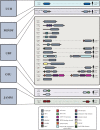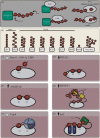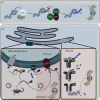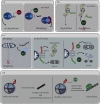The structure and function of deubiquitinases: lessons from budding yeast
- PMID: 33081638
- PMCID: PMC7653365
- DOI: 10.1098/rsob.200279
The structure and function of deubiquitinases: lessons from budding yeast
Abstract
Protein ubiquitination is a key post-translational modification that regulates diverse cellular processes in eukaryotic cells. The specificity of ubiquitin (Ub) signalling for different bioprocesses and pathways is dictated by the large variety of mono-ubiquitination and polyubiquitination events, including many possible chain architectures. Deubiquitinases (DUBs) reverse or edit Ub signals with high sophistication and specificity, forming an integral arm of the Ub signalling machinery, thus impinging on fundamental cellular processes including DNA damage repair, gene expression, protein quality control and organellar integrity. In this review, we discuss the many layers of DUB function and regulation, with a focus on insights gained from budding yeast. Our review provides a framework to understand key aspects of DUB biology.
Keywords: deubiquitinases; protein degradation; ubiquitin signalling.
Conflict of interest statement
We declare we have no competing interests.
Figures





Similar articles
-
Mechanisms of Deubiquitinase Specificity and Regulation.Annu Rev Biochem. 2017 Jun 20;86:159-192. doi: 10.1146/annurev-biochem-061516-044916. Epub 2017 May 12. Annu Rev Biochem. 2017. PMID: 28498721 Review.
-
Breaking the chains: deubiquitylating enzyme specificity begets function.Nat Rev Mol Cell Biol. 2019 Jun;20(6):338-352. doi: 10.1038/s41580-019-0099-1. Nat Rev Mol Cell Biol. 2019. PMID: 30733604 Review.
-
The emerging roles of deubiquitinases in plant proteostasis.Essays Biochem. 2022 Aug 5;66(2):147-154. doi: 10.1042/EBC20210060. Essays Biochem. 2022. PMID: 35678302 Free PMC article. Review.
-
UL36 Encoded by Marek's Disease Virus Exhibits Linkage-Specific Deubiquitinase Activity.Int J Mol Sci. 2020 Mar 5;21(5):1783. doi: 10.3390/ijms21051783. Int J Mol Sci. 2020. PMID: 32150874 Free PMC article.
-
A family of unconventional deubiquitinases with modular chain specificity determinants.Nat Commun. 2018 Feb 23;9(1):799. doi: 10.1038/s41467-018-03148-5. Nat Commun. 2018. PMID: 29476094 Free PMC article.
Cited by
-
Research Progress on the Role of Ubiquitination in Eye Diseases.Cell Biochem Biophys. 2024 Sep;82(3):1825-1836. doi: 10.1007/s12013-024-01381-y. Epub 2024 Jun 24. Cell Biochem Biophys. 2024. PMID: 38913283 Review.
-
SMURF1-mediated ubiquitylation of SHP-1 promotes cell proliferation and invasion of endometrial stromal cells in endometriosis.Ann Transl Med. 2021 Mar;9(5):362. doi: 10.21037/atm-20-2897. Ann Transl Med. 2021. PMID: 33842583 Free PMC article.
-
Role of USP13 in physiology and diseases.Front Mol Biosci. 2022 Sep 14;9:977122. doi: 10.3389/fmolb.2022.977122. eCollection 2022. Front Mol Biosci. 2022. PMID: 36188217 Free PMC article. Review.
-
The Deubiquitinating Enzyme MrUbp14 Is Involved in Conidiation, Stress Response, and Pathogenicity in Metarhizium robertsii.Front Fungal Biol. 2022 May 16;3:896466. doi: 10.3389/ffunb.2022.896466. eCollection 2022. Front Fungal Biol. 2022. PMID: 37746165 Free PMC article.
-
Nuclear Ubiquitin-Proteasome Pathways in Proteostasis Maintenance.Biomolecules. 2021 Jan 4;11(1):54. doi: 10.3390/biom11010054. Biomolecules. 2021. PMID: 33406777 Free PMC article. Review.
References
Publication types
MeSH terms
Substances
Grants and funding
LinkOut - more resources
Full Text Sources
Molecular Biology Databases

